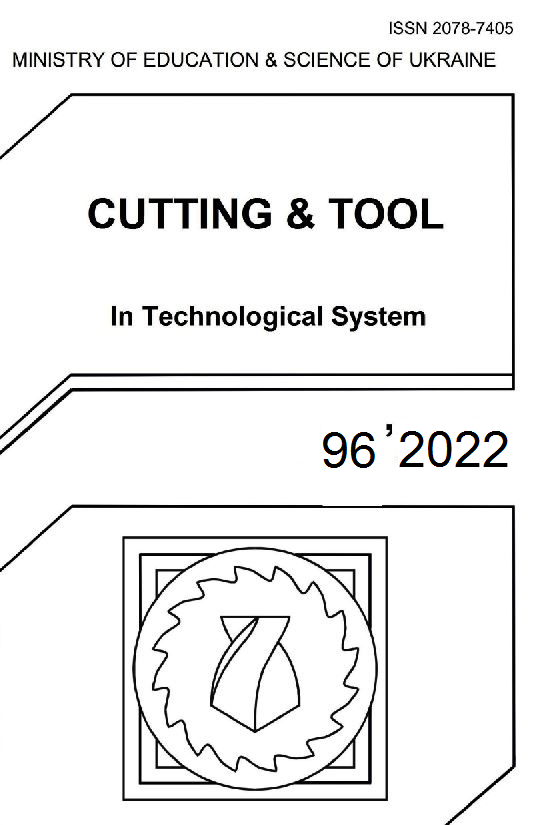THE RALATIONSHIP BETWHEEN THE PARAMETERS OF ROUGHNESS AND FEATURES OF SURFACE FORMATION WITH A SPECIAL MICROPROFILE
DOI:
https://doi.org/10.20998/2078-7405.2022.96.11Keywords:
parameters of the roughness, the ratio of height parameters of roughness Rmax/Ra, special microprofileAbstract
This article shows the regularities of the formation of the relationship between the parameters of the roughness of the treated surface under the conditions of processing with a tool made of superhard materials. Features of formation of the ratio of height parameters of roughness Rmax/Ra for conditions of diamond-abrasive processing are shown. In general, in relation to Rmax/Ra we have a kind of "roughness arc", when first for a normal untreated rough source surface it is close to 4, then abrasive-diamond treatment of this surface raises this ratio to 6 and then to 8, but further methods of abrasive finishing and polishing reduce the ratio to 6 and then chemical-mechanical polishing to a high-quality surface returns this ratio to values close to 4. This means that if the initial cost of grinding the original surface affects the increase in the ratio, then the subsequent cost of finishing and polishing work reduces the value of the ratio Rmax/Ra to the original. The peculiarities of obtaining a treated surface with a special microprofile, which is a flat protrusions with recesses (a kind of "pockets") for placing oil to increase the service life of such a surface.
References
Lavrinenko, V.I. and Novikov, M.V., Nadtverdi abrazyvni materiali v mekhanoobrobtsi: entsiklopedichnii dovidnik [Superabrasive Materials in Machining Operations: Encyclopedic Handbook], Novikov, M.V., Ed., Kyiv: Inst. Sverkhtverd. Mater., Nats. Akad. Nauk Ukr., 2013.
Puthanangady T. Recept Grinding Process Developments in the Optical Fiber Communication Industry // Gohram conferences : Precision Grinding & Finishing in the Global Economy – 2001, Chicago, October, 1 – 3, 2001.
Some Specific Features Inherent in the Relation between the Roughness Parameters of a Treated Surface under Grinding Wheels with a Mixture of SHM Grinding Powders with Superficially Modified Grains / V.I. Lavrinenko, O.O. Pasichnyi, V.G. Poltoratskyi, V.Yu. Solod, V.L. Dobroskok, E.V. Ostroverkh. Journal of Superhard Materials, 2021, Vol. 43, No. 6, pp. 444–454. 4. Novikov, F.V., Vysokoprodyktuvne almazne shlifuvannia [High-performance diamond grinding]. Kharkiv: CHNEU, 2014. 412 p.
Novikov F.V., and Shkurupiy V.G. Vlijanie fornu rezyschih zeren pri abrazivnoj obrabotke na parametru sherohovatosti poverchnosti [Influence of the shape of cutting grains during abrasive treatment on the surface roughness parameters]. Fizicheskie i kompjuternue technologii. Trudy XXI Mezdunarodnoi nauchno-prakticheskoi konferencii. [Physical and computer technologies. Proceedings of the XXI International. scientific-practical conference], Kharkiv, 2015. pp. 3–13.
Fizichni zasadu formoutvorennia precizinuch poverkhon pid chas mechinicnoi obrobki nemetalevich materialov [Physical principles of forming precision surfaces during machining of non-metallic materials] Yu.D. Filatov, VI Sidorko, O.Yu. Filatov, S.V. Kovaliov. Кyiv: Nauk. dumka, 2017. 247 p.
Chepovetsky I.H. Mehanika kontaknogo vzaimodeistvija pri almaznoi obrabotke [Mechanics of contact interaction in diamond processing]. Кyiv: Nauk. dumka, 1978. 238 p.
Lavrinenko, V.I., Sytnyk, B.V., Poltorats’ky, V.G., Bochechka, O.O., and Solod, V.Yu., Composites based on cBN micron powders structured by carbon binder for the application as functional elements in the working layer of diamond-abrasive tools. Part 1. Composite grits as abrasive elements, J. Superhard Mater., 2014, vol. 36, no. 3, pp. 193–198.
Downloads
Published
Issue
Section
License
Copyright Notice
Authors who publish with this Collection agree to the following terms:
1. Authors retain copyright and grant the Collection right of first publication with the work simultaneously licensed under a Creative Commons Attribution License that allows others to share the work with an acknowledgement of the work's authorship and initial publication in this Collection.
2. Authors are able to enter into separate, additional contractual arrangements for the non-exclusive distribution of the Collection's published version of the work (e.g., post it to an institutional repository or publish it in a book), with an acknowledgement of its initial publication in this Collection.
3. Authors are permitted and encouraged to post their work online (e.g., in institutional repositories or on their website) prior to and during the submission process, as it can lead to productive exchanges, as well as earlier and greater citation of published work.

